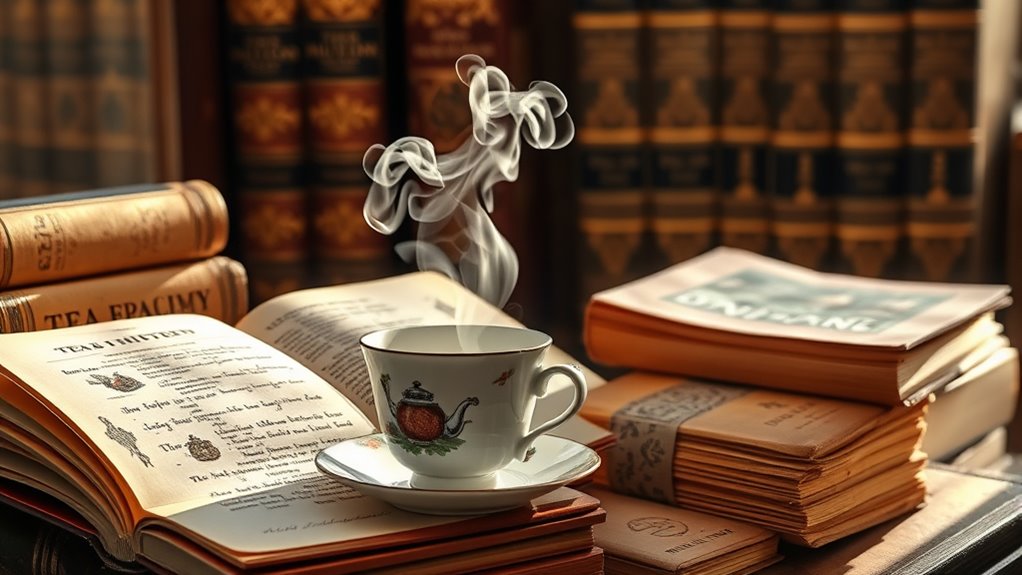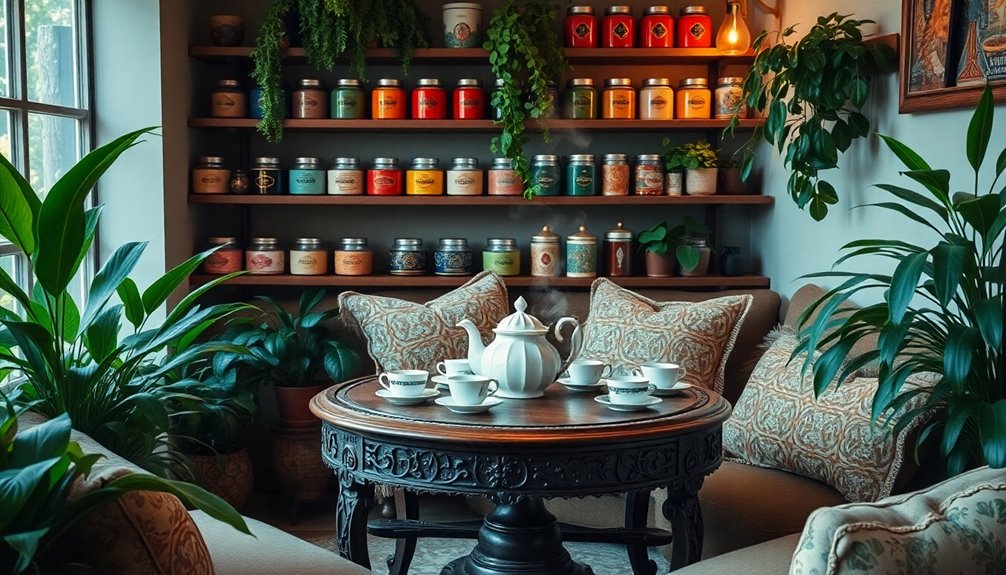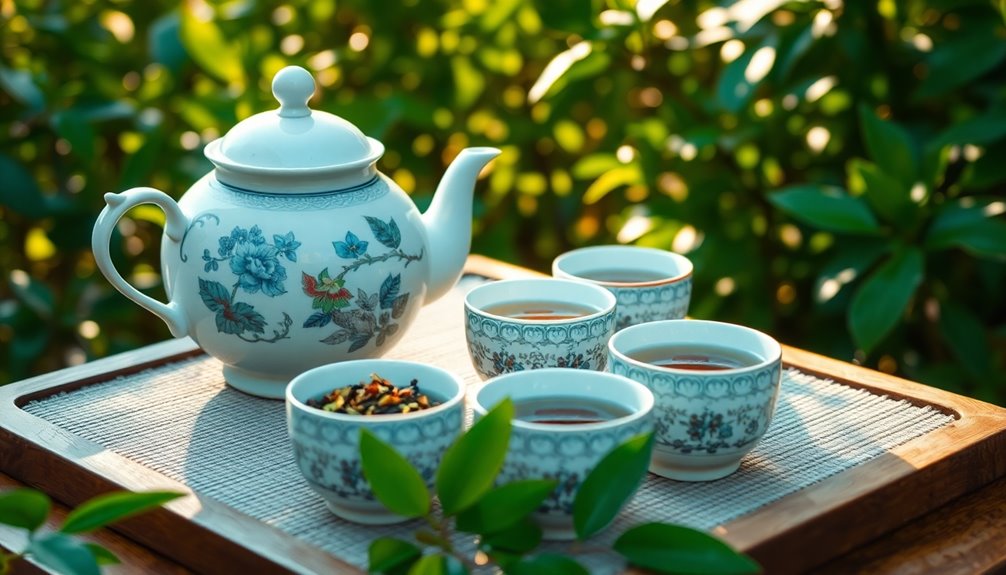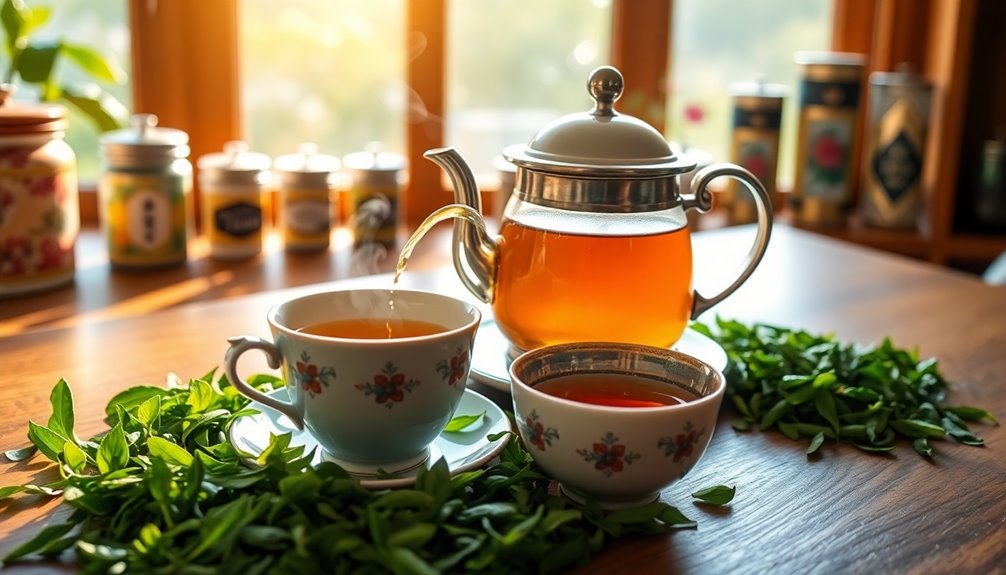Tea books and literature influence your view of culture by showcasing traditions, rituals, and symbolism that reflect societal values across generations. They reveal how tea ceremonies embody ideals like hospitality, mindfulness, and harmony, acting as symbols of identity and continuity. Through stories and poetry, you see how tea connects different cultures and represents shared human experiences. Keep exploring, and you’ll discover even more about how tea shapes cultural identities worldwide.
Key Takeaways
- Tea literature shapes cultural identities by illustrating social rituals, spiritual practices, and symbolic meanings across various societies.
- Literary depictions of tea ceremonies reflect core cultural values like respect, hospitality, and harmony.
- Tea is used in literature as a symbol of tranquility, connection, and spiritual awakening, influencing societal perceptions.
- Stories highlight tea’s role as a cultural bridge, fostering understanding and shared human experiences across different traditions.
- Classic tea books preserve and transmit cultural heritage, showcasing tea’s enduring influence on social and spiritual practices worldwide.

Tea books and literature have long played an essential role in shaping cultural identities and traditions around the world. As you explore these texts, you begin to see how deeply intertwined tea is with social rituals, spiritual practices, and symbolic meanings. One of the most significant aspects of this relationship is the depiction of tea ceremonies in literature, which serve as more than just formalized rituals—they embody cultural values like hospitality, mindfulness, and harmony. When authors describe a tea ceremony, they often highlight its meticulous steps, emphasizing patience, respect, and unity. These detailed portrayals help you understand that tea isn’t merely a beverage but a conduit for cultural expression. Through literary descriptions, you get a window into the customs that define different societies, from the elaborate Japanese tea ceremonies to the more casual British teatime. These rituals become symbols of identity and continuity, passed down through generations and immortalized in stories and poetry. They also serve as moments of reflection, where characters and readers alike pause to appreciate beauty in simplicity.
Literary symbolism further elevates tea’s role in cultural storytelling. Tea often represents more than just a drink; it symbolizes tranquility, social connection, or spiritual awakening. When authors write about tea, they imbue it with layered meanings that resonate beyond the narrative. For example, a scene where characters share tea might symbolize reconciliation or shared understanding, illustrating how a simple act can carry profound emotional weight. You notice how writers use tea to evoke a sense of tradition or to mark rites of passage, reinforcing the idea that tea’s significance extends beyond taste. In poetry and prose, tea can symbolize life’s fleeting moments or serve as a metaphor for inner peace amidst chaos. These literary symbols help you grasp how societies use tea to articulate values and beliefs, making it a powerful motif that transcends mere consumption.
In literature, tea also acts as a bridge connecting different cultures and philosophies. It highlights shared human experiences—hospitality, reflection, connection—while celebrating cultural uniqueness. Through these stories, you see how tea embodies cultural identity and influences social norms. Whether it’s a quiet moment of contemplation or a lively gathering, tea’s symbolic presence in literature underscores its importance as a cultural artifact. By engaging with these texts, you gain a deeper appreciation for how tea and its ceremonies shape societal values, and how literary symbolism captures the essence of these traditions. Ultimately, tea books and literature serve as timeless testimonies to the enduring cultural influence of tea across the globe.
Frequently Asked Questions
How Has Tea Literature Evolved Over Different Historical Periods?
You see that tea literature has evolved greatly over historical shifts, reflecting changing societies and values. In earlier periods, it focused on the ritual and social aspects of tea, emphasizing tradition. Later, literary themes expanded to include personal reflection and cultural exchange, mirroring global interactions. Today, modern works explore environmental concerns and identity, showing how tea continues to inspire diverse narratives across eras.
Which Cultures Have the Most Prominent Tea-Related Literary Traditions?
You’ll find the most prominent tea-related literary traditions in Chinese and Japanese cultures. They deeply incorporate tea traditions and often use literary symbolism to explore themes like harmony and tranquility. In China, classical poetry celebrates tea’s spiritual qualities, while Japanese haiku and essays reflect on tea’s meditative role. These traditions highlight how tea’s cultural significance inspires rich literary expressions across these societies.
How Do Tea Books Influence Modern Tea Appreciation and Consumption?
Think of tea books as your map through a lush, ancient garden where every leaf and brew symbolizes a tea ritual. They guide you to appreciate the depth of tradition and the art of brewing. Literary symbolism in these books influences your modern tea appreciation, inspiring mindful consumption and reverence for tea’s cultural significance. By exploring these stories, you become part of a timeless ritual, enriching your tea experience.
Are There Specific Literary Genres Centered Around Tea Culture?
Yes, there are specific literary genres centered around tea culture, like tea poetry and brewing narratives. You’ll find poets capturing the serenity and social aspects of tea in their verses, while authors craft stories that explore the ritual of brewing and sharing tea. These genres deepen your appreciation, offering rich insights and vivid imagery that connect you to the traditions, history, and cultural significance of tea worldwide.
What Role Does Tea Literature Play in Promoting Intercultural Understanding?
You might be surprised to learn that over 60% of readers say tea symbolism in literature helps them understand different cultures better. Tea literature plays a crucial role in promoting intercultural understanding by showcasing diverse cultural practices through literary representations. These stories use tea as a symbol of hospitality and tradition, bridging gaps and fostering empathy across cultures. Engaging with these works deepens your appreciation for global perspectives on tea’s cultural significance.
Conclusion
So, next time you crack open a tea book, remember you’re not just sipping history—you’re practically a cultural connoisseur. Who knew that leaf could wield such influence? With every page, you’re immersed in centuries of tradition, rebellion, and refined taste. So go ahead, indulge in your literary cuppa. Just don’t be surprised if, after all that reading, you start to believe you’ve become a tea sage—one sip closer to cultural enlightenment. Cheers to that!









